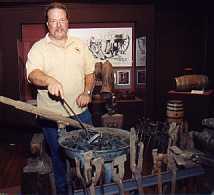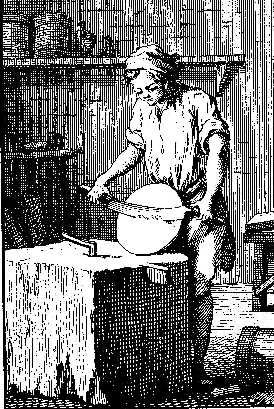

Man has a well-deserved reputation as Toolmaker. Workers in this trade have seen their way of work change beyond recognition or vanish in the accelerating technological evolution of the 20th century. This exhibit showcases several categories of tools that were important in the 19th and 20th centuries. Step back for a moment to a simpler time and revisit the tools your forefathers used to build America.
I. Living Room Gallery
Axe me another Imagine trying to build a house for yourself with nothing but an axe as your tool. This was often the case centuries ago when the log cabin was the first home of a generation of pioneers. Many builders had only this one hand-tool to work with. If they had a crosscut saw to cut down trees as well, they were considered lucky.
Among the most common cabin building tools were the broadax, the goose wing axe and the adze, which is a chisel with an axe handle. The felling axe was handmade with a wooden handle and a sharp bladed axe. An auger came in handy for drilling holes in logs for peg fittings, because metal nails were quite scarce.
Tools for Shingles: Two of the simplest tools of the time were the froe and the mallet. With a few whacks of the mallet, the froe was used to split off shakes of wood. The froe has been obsolete now for more than a century.
Victorian Gingerbread: Many kinds of intricately-shaped moldings found on Victorian houses were produced with hand tools, including saws, planes and drawknives.
Planes and Smoothing Tools: While the earliest woodworking planes date back to the 16th century, Stanley, an American company, started producing planes in1890. Some planes have up to 55 blades, which are used for detailed moldings and tight-fitting joints.
 Work
Bench and Boring Machine: Dating back to 1910, the boring machine was used to
drill holes in wood for home construction and shipbuilding. The machine is operated
with both hands. Two wooden handles are used for the high speed turning of the
bit. Not only does the bit drill vertically, it also moves back and forth laterally
to route a slot of up to three inches wide.
Work
Bench and Boring Machine: Dating back to 1910, the boring machine was used to
drill holes in wood for home construction and shipbuilding. The machine is operated
with both hands. Two wooden handles are used for the high speed turning of the
bit. Not only does the bit drill vertically, it also moves back and forth laterally
to route a slot of up to three inches wide.
Foot Treadle Saw: Often referred to as a jig saw, this bicycle-like tool cuts intricate patterns into wood, such as dovetails and, of course, jigsaw puzzles. The pedaling of the machine operates a finely toothed blade in a vertical cutting motion.
Measuring and Marking: Square-shaped devices are used for measuring right angles, trammel points for marking circles, and plumb bobs are used for perfectly vertical measurements. Levels are used for horizontal measurement.
Carpenter Tools: A hammer, plane, and square nails were a few of the carpenters most valued tools. Round nails weren't around until the end of World War I. Should you find an item made with square nails, you will know it was constructed before 1918.
II. Dining Room Gallery
 Blacksmith Display c. 1900: The typical
blacksmith shop revolved around the forge, a type of furnace where metals were
wrought. Bellows and ball-bearing blowers provided oxygen to keep the fire going.
Blacksmith Display c. 1900: The typical
blacksmith shop revolved around the forge, a type of furnace where metals were
wrought. Bellows and ball-bearing blowers provided oxygen to keep the fire going.
The blacksmith used many kinds of
tools, and most of them he made himself.
Pincer tongs with serrated grabbers were used for holding horseshoes, and for
picking up heavy round irons. Fullers and peens were used to make holes in red-hot
metal. A 100-pound anvil served as the blacksmith's workbench when he needed
a place to pound out random pieces of iron.
Besides horseshoes, the blacksmith also made specialty fittings, branding irons, even special clamps for quilt framing.
 Cooper Tools: In a time long before plastics and Tupperware, the barrel-making occupation - known as coopering - was a thriving industry. The art of coopering, or barrelmaking, is one of great antiquity and was probably developed from basketmaking. The shape of the cooper's barrel is a cylinder with bulging sides. How this peculiar shape was invented is not known; but it is the bulge (bilge) which gives the cask its strength. Barrels came in a great variety of sizes, some almost the size of a room, others not much larger than a football.
Cooper Tools: In a time long before plastics and Tupperware, the barrel-making occupation - known as coopering - was a thriving industry. The art of coopering, or barrelmaking, is one of great antiquity and was probably developed from basketmaking. The shape of the cooper's barrel is a cylinder with bulging sides. How this peculiar shape was invented is not known; but it is the bulge (bilge) which gives the cask its strength. Barrels came in a great variety of sizes, some almost the size of a room, others not much larger than a football.
Coopering was such an important craft that every town had at least one cooper. In 1866 beer production alone required the construction of five million barrels. Production became so efficient that by 1880 the cost of a barrel was only 32 cents.
As late as the 1890s there were over 50,000 coopers in the United States. Coopers also made buckets and other household items combining wood and metal.
There are two kinds of coopers: Wet Coopers (tight barrel) who made barrels for liquids, and Dry Coopers (slack barrel) who made barrels for transporting dry merchandise.
Over 400 different barrel-making inventions were patented in the US between 1844 and 1883. Consider the example of Maria Beasley of Philadelphia, who between 1878 and 1891, received eight patents dealing with the barrel-making industry. She turned out hundreds of ready-made barrels in a day and her barrel-making machine alone brought her $20,000 a year.
The cooper used tools called in-shaves to smooth the insides of the barrels. The croze cut the groove around the top of the barrel, for the securing of the barrel lid. The head shave is a specialized plane, used to smooth the head of the barrel.
A most important part of the barrel-maker's tool kit was the bung borer, which was used to bore the hole for the spigot, so the contents of the barrel could be tapped.
Smaller barrels served as refill containers for everything from apple cider to vinegar.
 Wheelwright: Members of a 3,000-year-old trade, wheelwrights (wheel and wagon makers)worked with both wood and iron. In America, the blacksmith was often the village wheelwright. He hired woodworkers as needed to make and assemble the felloes and spokes, and the axles and body of the wagon. Later axles were made of iron.
Wheelwright: Members of a 3,000-year-old trade, wheelwrights (wheel and wagon makers)worked with both wood and iron. In America, the blacksmith was often the village wheelwright. He hired woodworkers as needed to make and assemble the felloes and spokes, and the axles and body of the wagon. Later axles were made of iron.
A master blacksmith was needed to weld iron tires for the wheels. Tires must be shrunk on a wheel, which meant that a wheel must have a tire with no more than a 1/16" tolerance between the tire and the wheel. To measure accurately, the smith used a traveler, a metal or wooden measuring wheel. He then selected a tire iron of proper size and bent it into a circle. The ends were then overlapped, heated and welded together by hammering. The completed tire was next heated until it had expanded to the point where it could be prised over the rim with a tiredog or knocked into place with a sledge. Once properly mounted, the tire was quickly cooled by pouring water upon it or by immersing it in a pit of water until it was cool.
The decade of the 1870s saw the introduction of iron axles. In addition to the axles, the smith also made many small pieces of wagon hardware such as hinges, rivets, linch pins, braces, bearings and bands.
Farrier: Practically every blacksmith in the old days was also a farrier. The farrier was concerned with the the shoeing of horses and skilled in the preparation of the shoe, the horse's hoof and the nails used to fasten the shoe to the hoof. In the typical army of the 19th century and earlier, the farrier and the wheelwright were important technical support personnel for an army that relied upon horsepower for transport of men, artillery and supplies.
Special tools were needed for this exact art. Today's tools are almost exact duplicates of those used by ancient Roman and Middle Eastern farriers. The tool kit was usually hand-made, some-times resembling a carpenter's toolbox, with a carrying strap, partitions for horse shoeing nails, and a space for stowing the tools of the trade.
The tools in the kit included pincers for removing old shoes, a "buffer" for cutting off the clinched ends of old nails, and a rasp for making the hoof flat. Also needed were a "hoof cleaning knife", used to clean and trim the hoof, and a set of "hoof parers." These were used to trim the outside of the hoof. The "shoeing hammer" was a light claw hammer, easily mistaken for a carpenter's hammer, used to drive in the nails or remove the crookedly driven nails.
As in general forging, the farrier needed a forge, tongs, an anvil and hammers to make his own shoes. The hammer was often specially weighted to correct a gait or fit factory made shoes. The anvil was usually smaller than the shop anvil, but otherwise exactly the same.
III. Foundry Room
Sand casting dates back several hundred years. For a simple part, the pattern is placed on a board and the lower portion of the mold, called the drag, is placed over it. Molding sand is rammed onto the pattern until the drag is full.
Next the drag is turned over and the other half of the mold flask, called the cope, is placed on top and rammed with more sand. The cope and pattern are then removed, and gates and runners are cut to allow metal to flow into the drag cavity. The casting cools in about 30 minutes, and is then removed from the mold flask and readied for finishing.
With more complex patterns, such as steam engine parts and large gears, two half-molds are required.
A museum volunteer, John Grant is casting the parts required to make a two-cylinder steam engine. He has cast and assembled some sample parts already, for the purpose of testing his patterns and their mountings on the boards. The final steam engine parts will be cast in iron.
IV. Fireplace Room: Logger's tools and local history
Logging was the first industry on the Bay Area Peninsula. The vast supply of redwood trees growing on the hills of the Coast Range was used to build San Francisco. Among the local places named after the lumber industry are Woodside, Redwood City, Arastadero (meaning dragging road in Spanish) and Whiskey Hill, where loggers often stopped for drinks after work.
Sawmill Model: The development of the water-powered sash saw was not practical in the Woodside area, because of a lack of water. However, they worked very well in the Northwest and on the East Coast. Eventually the hydraulic sawmill led to the birth of the modern sawmill, as we know it today.
Donkey Engine: Patented in 1882, this power steam engine could run a sawmill. It replaced the need for large amounts of water and oxen and was highly transportable. It used a set of gears to turn a capstan, which reeled in rope or steel cable for moving logs.
Tabitha Babbitt
 Tabitha Babbitt (c, 1784-1854) was a Shaker from Harvard, Massachusetts, who invented the circular saw in 1810. The first blades were hand powered, but later versions were powered by water wheels and steam. Prior to the invention of the circular saw, logs were cut using two-man pit saws. The circular saw proved to be more efficient and more easily linked to power sources.
Tabitha Babbitt (c, 1784-1854) was a Shaker from Harvard, Massachusetts, who invented the circular saw in 1810. The first blades were hand powered, but later versions were powered by water wheels and steam. Prior to the invention of the circular saw, logs were cut using two-man pit saws. The circular saw proved to be more efficient and more easily linked to power sources.
Babbitt's other inventions included a new method of making false teeth, an improved spinning wheel head, and cut (as opposed to individually forged) nails. This latter invention enabled mass production of nails.
However, because of Babbitt's Shaker beliefs, she did not obtain patents for her inventions.
| Home |
 |
This
page last updated:
August 6, 2002
Original content: Copyright © 2000, 2001, 2002 Museum of American Heritage |